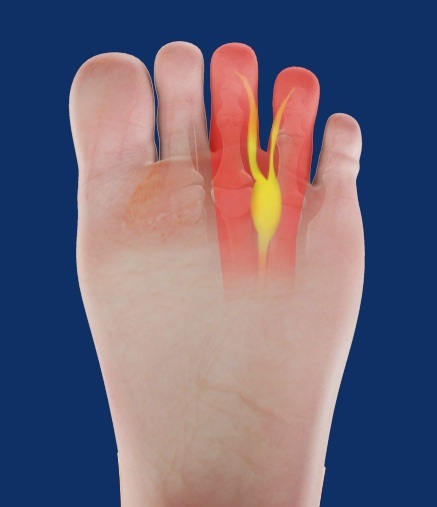Morton's Neuroma
Morton's neuroma refers to a nerve injury between the toes, usually the third and fourth toes, which causes pain and thickening of the nerve tissue. Compression or chronic irritation of this interdigital nerve is the main cause of Morton's Neuroma. Excess pressure is exerted on the nerves due to narrowing of the gap between the toe bones causing thickening of the nerve tissue from scar tissue formation. This causes swelling of the nerve and the surrounding tissue.

Morton's neuroma is more common in women than in men. The associated symptoms include:
- Burning pain in the ball of the foot (may also radiate to the toes)
- Numbness in the affected toes
- Inability to walk
- Wearing high-heeled or narrow shoes squeezes the toe bones and worsens these symptoms.
Your doctor can diagnose Morton's Neuroma by examining your foot. Palpation of the foot between the toes may reveal a thickened and tender area. A foot x-ray may be ordered to rule out other bone disorders.
Treatment:
Early treatment is critical to relieve pain. Mild to moderate cases of Morton's Neuroma can be managed by conservative treatment. Severe cases of neuroma may require surgery.
The conservative treatment measures include:
- Resting your foot and application of ice packs over the inflamed area to reduce swelling.
- Anti-inflammatory medications to help alleviate pain and inflammation
- Sclerosant injections such as alcohol ablation: In this procedure, highly concentrated alcohol is injected into the neuroma, under ultrasound guidance. The alcohol causes chemical destruction (sclerosis) of the fibrous nerve tissue.
- Simple footwear modifications include using low-heeled shoes and broad toe box shoes with special pads to minimize discomfort between of the toes.
- Physical therapy to relieve the pressure and improve the foot function
- Surgery is considered as the last option if in case the symptoms fail to resolve with the conservative treatments. Other indications include factors such as age and activity level of the individual, and extent of damage to the nerve.
Surgical treatment involves release of the compressed nerve by resection of the involved nerve (neurectomy) or the surrounding tissue.











